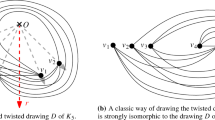Abstract
A drawing of a graph is x-monotone if every edge intersects every vertical line at most once and every vertical line contains at most one vertex. Pach and Tóth showed that if a graph has an x-monotone drawing in which every pair of edges crosses an even number of times, then the graph has an x-monotone embedding in which the x-coordinates of all vertices are unchanged. We give a new proof of this result and strengthen it by showing that the conclusion remains true even if adjacent edges are allowed to cross oddly. This answers a question posed by Pach and Tóth. Moreover, we show that an extension of this result for graphs with non-adjacent pairs of edges crossing oddly fails even if there exists only one such pair in a graph.
Access this chapter
Tax calculation will be finalised at checkout
Purchases are for personal use only
Preview
Unable to display preview. Download preview PDF.
Similar content being viewed by others
References
Bienstock, D., Dean, N.: Bounds for rectilinear crossing numbers. J. Graph Theory 17(3), 333–348 (1993)
Cairns, G., Nikolayevsky, Y.: Bounds for generalized thrackles. Discrete Comput. Geom. 23(2), 191–206 (2000)
Di Battista, G., Nardelli, E.: Hierarchies and planarity theory. IEEE Trans. Systems Man Cybernet. 18(6), 1035–1046 (1988, 1989)
Eades, P., Feng, Q., Lin, X., Nagamochi, H.: Straight-line drawing algorithms for hierarchical graphs and clustered graphs. Algorithmica 44(1), 1–32 (2006)
Estrella-Balderrama, A., Fowler, J.J., Kobourov, S.G.: On the Characterization of Level Planar Trees by Minimal Patterns. In: Eppstein, D., Gansner, E.R. (eds.) GD 2009. LNCS, vol. 5849, pp. 69–80. Springer, Heidelberg (2010)
Chojnacki, C., (Hanani, H.).: Über wesentlich unplättbare Kurven im drei-dimensionalen Raume. Fundamenta Mathematicae 23, 135–142 (1934)
Kleitman, D.J.: A note on the parity of the number of crossings of a graph. J. Combinatorial Theory Ser. B 21(1), 88–89 (1976)
Lin, X., Eades, P.: Towards area requirements for drawing hierarchically planar graphs. Theor. Comput. Sci. 292(3), 679–695 (2003)
Matoušek, J.: Using the Borsuk-Ulam theorem. Universitext. Springer, Berlin (2003); Lectures on topological methods in combinatorics and geometry, Written in cooperation with Anders Björner and Günter M. Ziegler
Matousek, J., Tancer, M., Wagner, U.: Hardness of embedding simplicial complexes in ℝd. In: Mathieu, C. (ed.) Proceedings of the Twentieth Annual ACM-SIAM Symposium on Discrete Algorithms, SODA 2009, New York, NY, USA, January 4-6, pp. 855–864. SIAM (2009)
Pach, J., Tóth, G.: Which crossing number is it anyway? J. Combin. Theory Ser. B 80(2), 225–246 (2000)
Pach, J., Tóth, G.: Monotone drawings of planar graphs. J. Graph Theory 46(1), 39–47 (2004)
Pach, J., Tóth Monotone, G.: Drawings of planar graphs. ArXiv e-prints (January 2011)
Pach, J., Tóth, G.: Monotone crossing number. In: Graph Drawing (to appear, 2011)
Pelsmajer, M.J., Schaefer, M., Štefankovič, D.: Removing even crossings. J. Combin. Theory Ser. B 97(4), 489–500 (2007)
Pelsmajer, M.J., Schaefer, M., Štefankovič, D.: Odd crossing number and crossing number are not the same. Discrete Comput. Geom. 39(1), 442–454 (2008)
Pelsmajer, M.J., Schaefer, M., Štefankovič, D.: Removing independently even crossings. SIAM Journal on Discrete Mathematics 24(2), 379–393 (2010)
Schaefer, M.: Hanani-Tutte and related results. To appear in Bolyai Memorial Volume
Tutte, W.T.: Toward a theory of crossing numbers. J. Combinatorial Theory 8, 45–53 (1970)
Author information
Authors and Affiliations
Editor information
Editors and Affiliations
Rights and permissions
Copyright information
© 2011 Springer-Verlag Berlin Heidelberg
About this paper
Cite this paper
Fulek, R., Pelsmajer, M.J., Schaefer, M., Štefankovič, D. (2011). Hanani-Tutte and Monotone Drawings. In: Kolman, P., Kratochvíl, J. (eds) Graph-Theoretic Concepts in Computer Science. WG 2011. Lecture Notes in Computer Science, vol 6986. Springer, Berlin, Heidelberg. https://doi.org/10.1007/978-3-642-25870-1_26
Download citation
DOI: https://doi.org/10.1007/978-3-642-25870-1_26
Publisher Name: Springer, Berlin, Heidelberg
Print ISBN: 978-3-642-25869-5
Online ISBN: 978-3-642-25870-1
eBook Packages: Computer ScienceComputer Science (R0)




